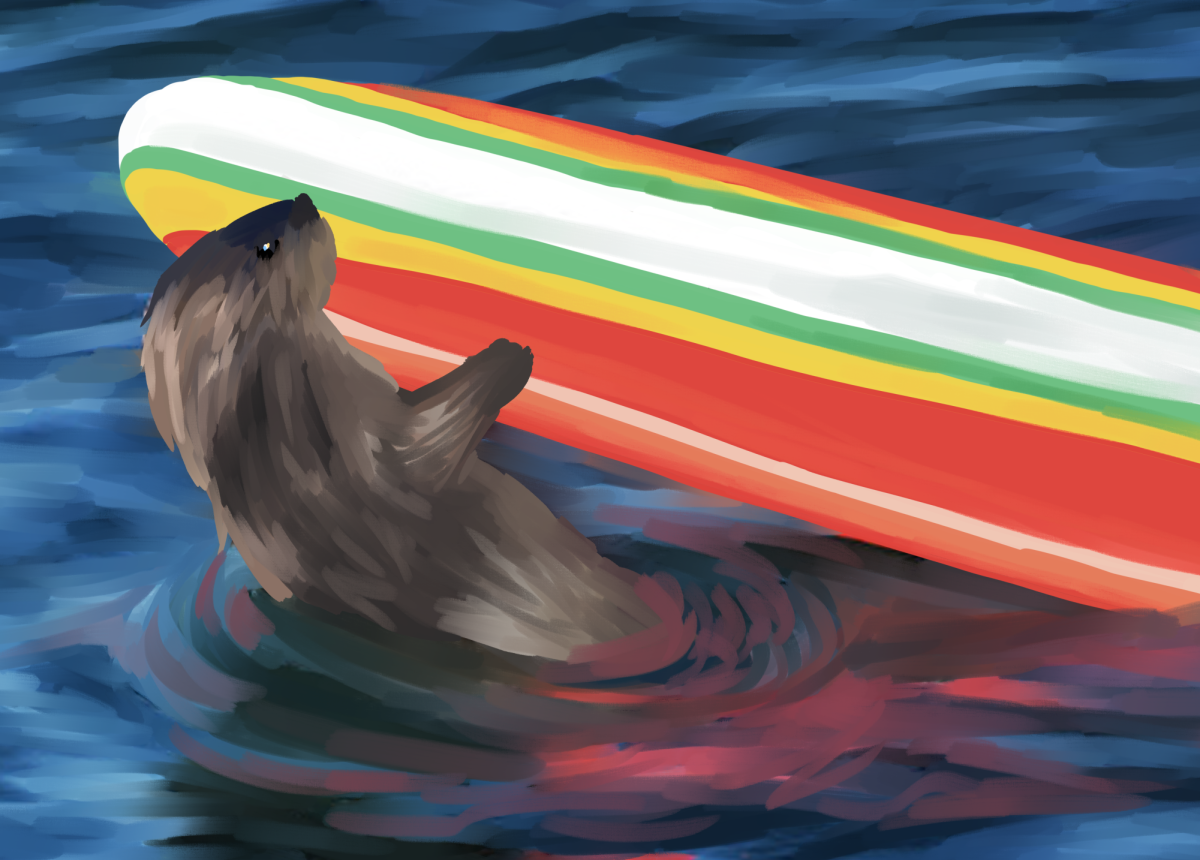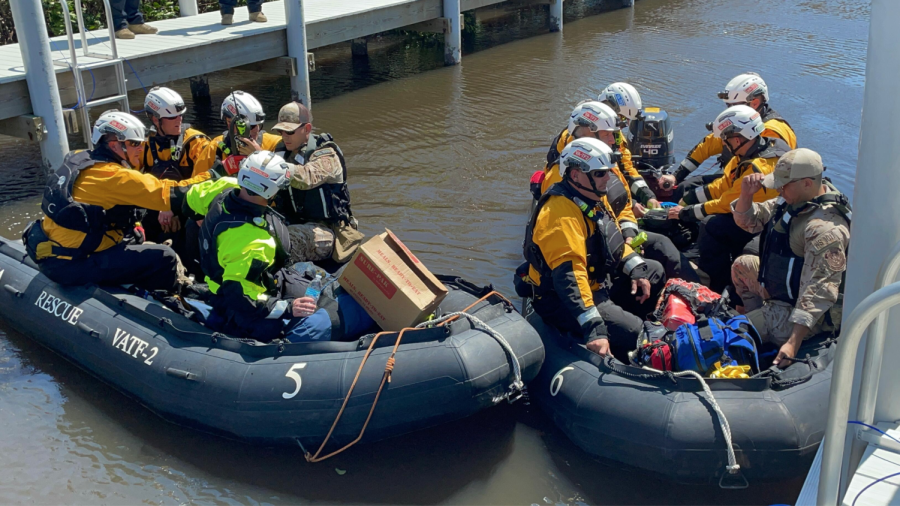As surfers ride the waves in the cool blue waters of Santa Cruz, one omnipresent threat looms over them all — an overly-social, delinquent sea otter. The aquatic outlaw, which local officials call Otter 841 (a name originating from her tag number during her prior captivity), has been pestering surfers in the Santa Cruz area by hijacking, stealing and damaging their surfboards. Although Otter 841’s interactions with surfers date all the way back to 2021, her heists grew more bold and frequent over this past summer.
Otter 841’s origin story begins at University of California Santa Cruz five years ago, when her mother, recently recaptured by officials due to concerns of illegal feeding, unexpectedly gave birth to her. Not long after, they transferred the newborn otter to Monterey Bay Aquarium. Caretakers attempted to distance Otter 841 from humans whenever possible so she wouldn’t grow accustomed to them upon her release to the wild. Despite these efforts, Otter 841 soon lost her fear for humans, kickstarting her life of crime.
Throughout the summer, several surfers in the Santa Cruz area reported incidents of the otter climbing atop their surfboards and flipping them over. Some even witnessed the otter tearing off pieces of boards with her sharp jaws and claws. In most cases, Otter 841 clinged on to surfboards and refused to let go, even as waves tossed her about. Due to these eccentric encounters, authorities set out to capture the female otter, although attempts have yet to be successful.
“[Otters] are intelligent, crafty creatures that live in an environment with a lot of predators, and they are also themselves a predator. So I imagine they are pretty inquisitive,” upper school chemistry teacher and avid kayaker Andrew Irvine said.
Otters, a member of the Weasel family, naturally possess webbed feet for swimming and flexible forepaws that allow them to pull and grip with considerable strength. However, their real power lies within their jaws and teeth, capable of piercing the exoskeleton of sea urchins and cracking open clam shells. Many different species of otters exist, such as the sea otter, the North American river otter, Eurasian otters and giant otters. Among these types, sea otters rank fairly high in the size category, with females weighing up to 50 pounds and males weighing up to 70 pounds.
“They’re big animals, four or five feet long, and they’ve got very sharp teeth. I have spent 35 years out in the ocean near otters and never seen an incident with an otter,” upper school biology teacher Mike Pistacchi said. “But, like anything else, just like a cat, otters sometimes go nuts. They’re wild animals.”
Typically, sea otters mind their own business, peacefully swimming and floating around on their backs within kelp forests, occasionally diving down for food. However, human interference, such as feeding, can change their behavior.
“A few months ago, I visited the Santa Cruz Beach Boardwalk with my family, and we spotted an otter during a kayak tour,” Nikhil Pesati (11), who frequents Santa Cruz, said. “It was pretty cute how it dove down under the water and then popped back up. Otters definitely don’t seem like the aggressive type, so I’m not sure why this specific otter would behave in such a confrontational manner.”
Despite how passive otters seem on the surface, they are still social and curious creatures. Once they become comfortable with humans, they will begin to interact more frequently. Some speculate that otter 841’s abnormal behavior stems from repeated human encounters.
“There’s a long history of problems with captive-raised animals thriving in the wild because they interact with humans in negative ways,” Pistacchi said. “So, as much as possible, scientists need to make sure to raise captive animals in ways that keep them from becoming habituated to humans.”
In California, the Marine Mammals Regulation Act, passed in 1972, deems it illegal to feed or pet marine animals, such as otters, seals, dolphins and sea turtles. Ultimately, these laws help to protect both the humans and the animals involved. Feeding wild critters can impair an animal’s ability to gather food on their own, while touching or petting wild critters can create dangerous, lose-lose situations, harming both the animal and the human. So, with animals in the wild, it’s better to keep your distance.
“[Wild animals] are something that we have here [on campus],” Irvine said. “There was a squirrel that would enter into the journalism room, and I advised that they didn’t encourage that behavior, because squirrels are wild animals after all. It’s important to not create [a] dependence because it’s not healthy for that animal, their behavior and the ecosystem as a whole.”


















![“[Building nerf blasters] became this outlet of creativity for me that hasn't been matched by anything else. The process [of] making a build complete to your desire is such a painstakingly difficult process, but I've had to learn from [the skills needed from] soldering to proper painting. There's so many different options for everything, if you think about it, it exists. The best part is [that] if it doesn't exist, you can build it yourself," Ishaan Parate said.](https://harkeraquila.com/wp-content/uploads/2022/08/DSC_8149-900x604.jpg)




![“When I came into high school, I was ready to be a follower. But DECA was a game changer for me. It helped me overcome my fear of public speaking, and it's played such a major role in who I've become today. To be able to successfully lead a chapter of 150 students, an officer team and be one of the upperclassmen I once really admired is something I'm [really] proud of,” Anvitha Tummala ('21) said.](https://harkeraquila.com/wp-content/uploads/2021/07/Screen-Shot-2021-07-25-at-9.50.05-AM-900x594.png)







![“I think getting up in the morning and having a sense of purpose [is exciting]. I think without a certain amount of drive, life is kind of obsolete and mundane, and I think having that every single day is what makes each day unique and kind of makes life exciting,” Neymika Jain (12) said.](https://harkeraquila.com/wp-content/uploads/2017/06/Screen-Shot-2017-06-03-at-4.54.16-PM.png)








![“My slogan is ‘slow feet, don’t eat, and I’m hungry.’ You need to run fast to get where you are–you aren't going to get those championships if you aren't fast,” Angel Cervantes (12) said. “I want to do well in school on my tests and in track and win championships for my team. I live by that, [and] I can do that anywhere: in the classroom or on the field.”](https://harkeraquila.com/wp-content/uploads/2018/06/DSC5146-900x601.jpg)
![“[Volleyball has] taught me how to fall correctly, and another thing it taught is that you don’t have to be the best at something to be good at it. If you just hit the ball in a smart way, then it still scores points and you’re good at it. You could be a background player and still make a much bigger impact on the team than you would think,” Anya Gert (’20) said.](https://harkeraquila.com/wp-content/uploads/2020/06/AnnaGert_JinTuan_HoHPhotoEdited-600x900.jpeg)

![“I'm not nearly there yet, but [my confidence has] definitely been getting better since I was pretty shy and timid coming into Harker my freshman year. I know that there's a lot of people that are really confident in what they do, and I really admire them. Everyone's so driven and that has really pushed me to kind of try to find my own place in high school and be more confident,” Alyssa Huang (’20) said.](https://harkeraquila.com/wp-content/uploads/2020/06/AlyssaHuang_EmilyChen_HoHPhoto-900x749.jpeg)
























